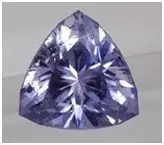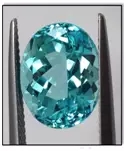The Blue Phantom of Paraiba in the Tourmaline
Paraiba
Tourmaline is known for its rich colors. The Paraiba variety in the tourmaline, with its unique bright blue color, adds a touch of bright color to the colorful tourmaline family, like a “blue phantom†in the colorful scroll, attracting many investors and jewelers. Collection fans pay attention.
In recent years, Paraiba has whipped up a fierce whirlwind in the international market, sparking hot debates about its origin, hot market prices, marketing promotions, etc., while also driving other similar blues. The variety of gemstones is hot.
When this "Blue Phantom" whirlwind was blown into the testing laboratory, its definition of color, improvement of its own color, and similar varieties of "imposing" became one of the hot topics in tourmaline detection. The NGTC Lab is here to interpret you - Paraiba's "Blue Phantom".
First, the "magic" of Paraiba
01. ParaÃba tourmaline name source
The name of Paraiba is derived from its discovery – the state of ParaÃba in Brazil. The discoverer Heitor Dimas Barbosa began searching for gems in the relevant areas in the early 1980s. He spent several years in 1989. The Minada Batalha mine discovered a bright neon blue tourmaline and named it the tourmaline of ParaÃba.
02. Paraiba Tourmaline color source
The rich color of the tourmaline is caused by some traces of the coloring elements in the tourmaline, especially the metal elements of some transitional groups, entering its lattice.
The color of Paraiba tourmaline is closely related to the two elements of copper and manganese.
03. ParaÃba tourmaline name dispute
This blue-blue-green tourmaline was also found in Nigeria and Mozambique, as well as copper and manganese. The discovery of the blue-green tourmalines in these two areas alleviated the shortage of ParaÃba Bibi in Brazil, but it also sparked controversy about the name of ParaÃba.
The main issues of the dispute:
Can the blue-blue-green tourmaline in Africa's two producing areas be called "ParaÃba Tourmaline"?
What color characteristics of the tourmaline can be called Paraiba?
The international colored gemstones have held a series of discussions around the origin, color, etc., and finally gave the definition of Paraiba Tourmaline, which is widely recognized by the market.
Paraiba tourmaline definition: It is a general term for blue, blue-green, yellow-green, purple-blue tourmaline containing copper and manganese, not limited to the place of origin.
Second, the determination of "Blue Phantom"
01. Determine the conditions of Paraiba Tourmaline
According to the international definition of Paraiba Tourmaline, the laboratory follows two important conditions in its testing and identification:
One is the color range: it must be blue (electro-optic blue, neon blue, purple blue), blue-green, green-blue, green, and yellow-green.
The second is the coloring element: it must be colored for copper and manganese, that is, it needs to contain copper and manganese.
The two conditions are indispensable.
02. Laboratory analysis and analysis methods and steps
The first step of the conventional method, infrared spectroscopy and other tests, confirmed to be tourmaline;
The second step is to visually judge the color range according to the naked eye observation;
In the third step, the determination of the coloring elements was confirmed by means of X-ray fluorescence spectrometer, laser ablation plasma mass spectrometer and ultraviolet-visible absorption spectrometer to confirm the presence of copper and manganese.
03. Representation on the test certificate
After confirming the color range and coloring elements of the tourmaline sample, the laboratory confirms that it is a Paraiba tourmaline and is named “Bixiâ€, which can be marked in the remarks column of the inspection certificate. For example, “The copper and manganese elements are included. Blue-blue-green tourmaline Paraiba-TypeTourmaline" to indicate the special identity of Paraiba.
04. Not all blue and green tourmalines
Paraiba
The rich color range of tourmaline includes blue, green and other colors with different hue, saturation and brightness, such as blue with gray blue, dark blue, dark blue, blue and black, etc., in the production of the tourmaline, the market supply very common. The color-causing elements of these blue-green tourmalines are mainly iron, which is significantly different from the Paraiba tourmaline in terms of color hue, brightness and saturation.
According to the international definition, all blue-green tourmalines of iron-colored color cannot be called Paraiba tourmaline.
05. Color improvement of Paraiba Tourmaline
The production of the ParaÃba tourmaline in the mining area has a wide range of colors, including blue, blue-green, green, yellow-green, and purple-blue. The bright blue-blue-green color of the market is the most precious. In order to improve the quality of the Paraiba tourmaline, most Paraiba tourmalines undergo a certain degree of heat treatment.
The heat treatment of Paraiba tourmaline is mainly to reduce the valence state of manganese ions by heating in a reducing environment, to convert trivalent manganese into divalent manganese, to weaken or even eliminate the purple tone, thereby obtaining a purer and more saturated blue. (Figure 1).
Since the heat treatment temperature of Paraibaba is relatively low, it has little effect on other characteristics except color, and the color after treatment is also very stable. In the national standard GB/T16552 jewellery and jade name, the heat treatment of tourmaline is optimized, and the name is not marked with “heat treatmentâ€.


Figure 1 Comparison of ParaÃba tourmaline before and after heat treatment
06. Filling treatment of Paraiba tourmaline
Like other tourmalines, Paraiba tourmalines are characterized by large brittleness, numerous fissures, and rich internal inclusions. The various manual treatments of tourmaline are commonly found in filling treatments, as well as in Paraiba. The aim is to increase the yield of Paraiba tourmaline and improve its appearance, especially clarity, transparency, material use and sales value.
The materials used in the filling of Paraiba tourmaline are often some organic polymeric materials. According to reports, the American Gem Improvement Processing Company, known for its emerald filling process, is now accepting the business of filling the tourmaline, including Paraiba Tourmaline. From the comparison of the effect before and after the display of Paraiba tourmaline filling treatment, the appearance is very different (Fig. 2), and the possible price changes before and after the treatment can be imagined, so it is fully revealed whether it has been filled and filled. The degree, etc., is very important to consumers.


Figure 2 Comparison of ParaÃba Tourmaline before and after filling treatment
The detection method of gem filling treatment is basically the same. That is, by amplifying the inspection to observe whether there is a difference in surface gloss, bubbles, and a special flash effect, and combining with infrared spectroscopy and the like, whether to test whether the filling and filling materials are formed, and whether the identification sample is subjected to filling treatment.
The filling test steps of Paraiba Tourmaline are basically the same, but the difficulty of observing the filling characteristics under the microscope is greater than that of emeralds and other varieties, which is a greater challenge to the knowledge and experience of the inspectors!
Third, similar varieties of Paraiba tourmaline
In the NGTC laboratory received the original sample named "Paraibaba Tour", there are other varieties of similar colors such as apatite and glass in the test results.
01. With the appearance of Paraiba Tourmaline
The closest natural gem: apatite
Naturally produced apatite is also very rich in color, of which the blue-green variety is very close to the color of Paraiba, and even there is a saying called "Palaiba" apatite on the market. The blue-green apatite has been plunged into the paradise of ParaÃba, and its value has doubled in recent years.
Since the refractive index of apatite is similar to that of tourmaline, ParaÃba apatite is somewhat confusing by visual observation. However, some other gemological characteristics of apatite, such as hardness, UV-visible absorption spectrum, infrared spectrum and other characteristics are very different from Paraiba tourmaline, which can be easily distinguished in the laboratory by these means.
02. The cheapest ParaÃba Bibi imitation: glass
Glass can be made into a variety of colors, gloss, transparency products, mature production process, huge output, can be described as the cheapest, most accessible universal gem imitation. Glass has also become the main imitation of Paraiba.
The blue glass of the lake, at first glance, has a certain similarity with the Paraiba tourmaline, but the glass often has the characteristics of bubbles, agitated lines, etc., and it is easy to observe the difference with the Paraiba tourmaline in the laboratory; in the laboratory It can also be clearly distinguished from Paraiba Bibi by features such as magnification inspection, refractive index, and infrared spectroscopy.
Crewneck Blouse,Long Sleeve Blouse,Lace Blouse Women,Chiffon Blouse Shirt
Shaoxing Holly Garments Co., Ltd. , https://www.hollygarment.com